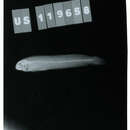Comprehensive Description
provided by Smithsonian Contributions to Zoology
Haptogenys bipunctata (Day)
On the basis of information in Day (1876) Springer (1972a) assigned Petroscirtes bipunctatus from Calicut, India, to the genus Omobranchus, and noted that the holotype was lost. Menon and Yazdani (1968) did not mention the existence of the holotype in their purportedly complete catalog of the types in the collections of the Zoological Survey of India. W. F. Smith-Vaniz, who visited ZSIC in 1969 with the intention of examining all the blenniid types, was not apprised that it was present. Recently, Dr. P. Talwar (ZSIC) notified us that the type was available (ZSIC No. 2082). Information on the holotype, kindly furnished us by Dr. A. G. K. Menon, convinces us that P. bipunctatus is a species of Haptogenys and is undoubtedly the same as H. quadripora Springer, which we here place in synonymy with H. bipunctata (name emended here to agree with gender of the genus). Springer had but a single specimen (USNM) of H. bipunctata (as H. quadripora), from Koh Tao, Gulf of Thailand. Another specimen (MCZ 47202, female, 32.0 mm SL) of H. bipunctata, from Lam Goh Peninsula, south Thailand (6°57′N, 99°43′E), has also come to our attention. Both this specimen and the holotype of P. bipunctatus have three mandibular sensory pores, whereas the USNM specimen has two pores, indicating the probability that the USNM specimen is aberrant. The USNM specimen also may have been unsual in having the shortest pelvic-fin ray less than half the length (42.5%) of the longest. The MCZ specimen has the shortest ray 54.5% the length of the longest.
The following meristic data from the ZSIC and MCZ specimens expand the description of the species over that given by Springer; dorsal fin XII, 19 (2) anal fin II, 21 (2); pectoral fin 13 (MCZ); interorbital pores 4 (2); circumorbital pores 8 (MCZ); gill opening extending ventrally to pectoral-fin ray 13 (2); upper teeth 18 (MCZ); lower teeth 20 (MCZ). Ventral hypural plate autogenous.
- bibliographic citation
- Springer, Victor G. and Gomon, Martin F. 1975. "Revision of the blenniid fish genus Omobranchus, with descriptions of three new species and notes on other species of the tribe Omobranchini." Smithsonian Contributions to Zoology. 1-135. https://doi.org/10.5479/si.00810282.177
Comprehensive Description
provided by Smithsonian Contributions to Zoology
Haptogenys quadripora
HOLOTYPE (only known specimen).–USNM 119658, male, 61.6 mm SL, 62.5 mm SL when measured from midtip of snout; Koh Tao Island, Gulf of Thailand, lat. 10°03' N, 99°51′ E; collected by H.M. Smith, 3 January 1927; specimen now cleared and stained.
DESCRIPTION.–Dorsal fin XII, 18; anal fin II, 20; pectoral fins 13–13; pelvic fins I,2–I,2; caudal fin (dorsal procurrent rays + segmented rays + ventral procurrent rays) 7+13+7; hypural 5 absent; two epurals; vertebrae 10+28; pleural ribs on vertebrae 3–10; epipleural ribs on vertebrae 1–12; upper jaw teeth I–22–I; lower jaw teeth I–26–I.
Proportions as percent SL: snout tip to gill opening 21.0, fleshy interorbital width 7.3, upper jaw length 6.2, gill opening depth 7.6, body depth at anal fin origin 16.6, third dorsal fin spine length (DS3) 10.2, DS5 9.9, DS12 7.0, first dorsal ray length (DRI) 10.4, DR5 11.7, DR18 7.5; longest pectoral fin ray 14.5, longest pelvic fin ray 14.8, shortest pelvic fin ray 6.3, longest caudal fin ray 23.6, last dorsal fin ray to midcaudal fin base 11.4, last anal fin ray to midcaudal fin base 9.8.
Dorsal fin origin slightly in advance of level of gill opening, notched slightly above last spine. Tips of most caudal fin rays exserted beyond margin of interradial membrane. Lateral line absent on body; no midpredorsal supratemporal sensory pore. Color pattern, if present, now almost completely faded. The only markings present are a spot on the anterior dorsal fin spines and another, larger spot on the antepenultimate dorsal fin spine.
ETYMOLOGY.–An adjective derived from the Latin quadri-, “four,” and the Greek poros “holes,” and referring to the four interorbital sensory pores.
Laiphognathus J. L. B. Smith, 1955, p. 23 [type-species: L. multimaculatus J. L. B. Smith, 1955, by original designation].
DIAGNOSIS.–Cirri present on rims of anterior and posterior nostrils; dorsal and anal fins not attached to caudal fin; frontal bones separate in adults; 5 circumorbital bones; no kinethmoid; postcleithra normal; nasal bones separate; ventral hypural plate fused to urostylar centrum; 11 (rarely 10 or 12) dorsal fin spines; 13 (rarely 12 or 14) pectoral fin rays; 9–12 sensory pores in circumorbital series; 3 sensory pores in mandibular series; 14–20 sensory pores in supratemporal-preoperculo-mandibular series; 3 interorbital sensory pores; posterior nostril present, normal; gill opening restricted to area above level of fourth from dorsalmost pectoral fin ray; shortest pelvic fin ray more than half length of longest.
RELATIONSHIPS.–The presence of cirri and the high number of pores in the circumorbital and supratemporal-preoperculo-mandibular series distinguish Laiphognathus from the other Omobranchini. These characters appear to be either specializations imposed on a basically Ombranchus-like form or the characters are primitive for the tribe. In the latter case, loss of cirri and decrease in the number of pores would be almost all that would be necessary to derive Omobranchus from Laiphognathus. However, the fusion of the ventral hypural plate to the urostylar centrum of Laiphognathus is a specialization not found in Omobranchus.
- bibliographic citation
- Springer, Victor G. 1972. "Synopsis of the tribe Omobranchini with descriptions of three new genera and two new species (Pisces: Blenniidae)." Smithsonian Contributions to Zoology. 1-31. https://doi.org/10.5479/si.00810282.130

